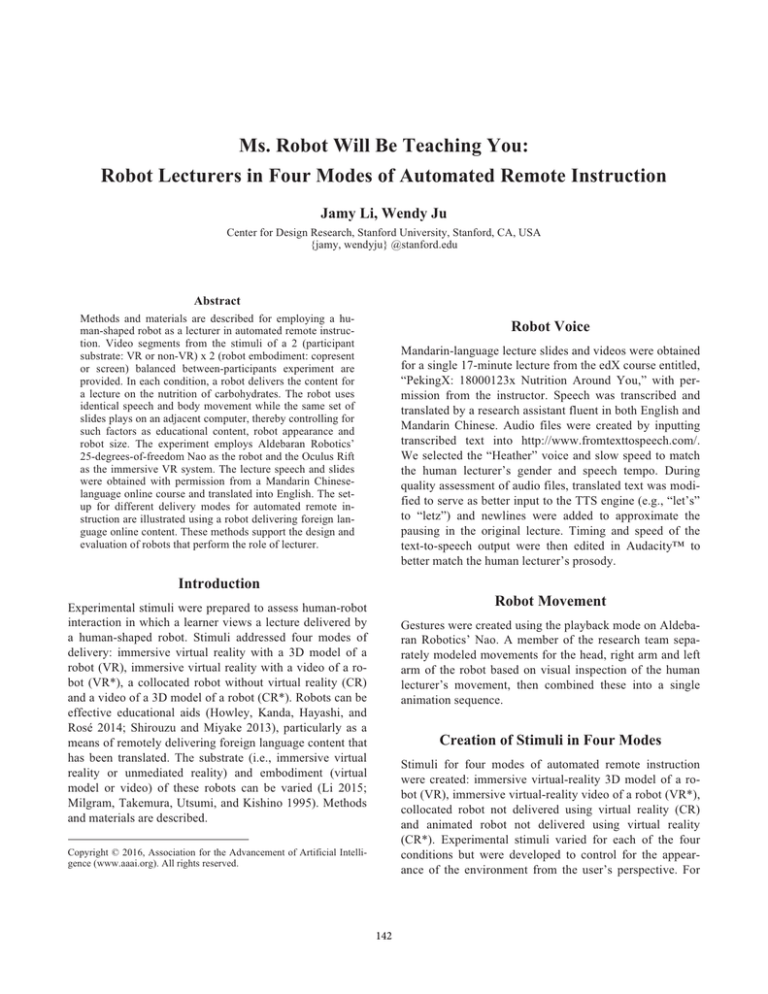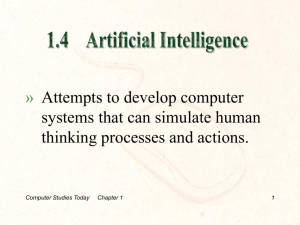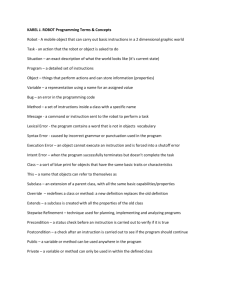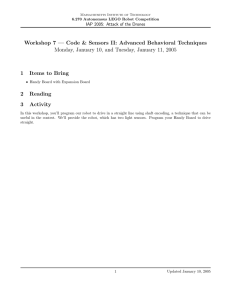
Ms. Robot Will Be Teaching You:
Robot Lecturers in Four Modes of Automated Remote Instruction
Jamy Li, Wendy Ju
Center for Design Research, Stanford University, Stanford, CA, USA
{jamy, wendyju} @stanford.edu
Abstract
Methods and materials are described for employing a human-shaped robot as a lecturer in automated remote instruction. Video segments from the stimuli of a 2 (participant
substrate: VR or non-VR) x 2 (robot embodiment: copresent
or screen) balanced between-participants experiment are
provided. In each condition, a robot delivers the content for
a lecture on the nutrition of carbohydrates. The robot uses
identical speech and body movement while the same set of
slides plays on an adjacent computer, thereby controlling for
such factors as educational content, robot appearance and
robot size. The experiment employs Aldebaran Robotics’
25-degrees-of-freedom Nao as the robot and the Oculus Rift
as the immersive VR system. The lecture speech and slides
were obtained with permission from a Mandarin Chineselanguage online course and translated into English. The setup for different delivery modes for automated remote instruction are illustrated using a robot delivering foreign language online content. These methods support the design and
evaluation of robots that perform the role of lecturer.
Robot Voice
Mandarin-language lecture slides and videos were obtained
for a single 17-minute lecture from the edX course entitled,
“PekingX: 18000123x Nutrition Around You,” with permission from the instructor. Speech was transcribed and
translated by a research assistant fluent in both English and
Mandarin Chinese. Audio files were created by inputting
transcribed text into http://www.fromtexttospeech.com/.
We selected the “Heather” voice and slow speed to match
the human lecturer’s gender and speech tempo. During
quality assessment of audio files, translated text was modified to serve as better input to the TTS engine (e.g., “let’s”
to “letz”) and newlines were added to approximate the
pausing in the original lecture. Timing and speed of the
text-to-speech output were then edited in Audacity™ to
better match the human lecturer’s prosody.
Introduction
Robot Movement
Experimental stimuli were prepared to assess human-robot
interaction in which a learner views a lecture delivered by
a human-shaped robot. Stimuli addressed four modes of
delivery: immersive virtual reality with a 3D model of a
robot (VR), immersive virtual reality with a video of a robot (VR*), a collocated robot without virtual reality (CR)
and a video of a 3D model of a robot (CR*). Robots can be
effective educational aids (Howley, Kanda, Hayashi, and
Rosé 2014; Shirouzu and Miyake 2013), particularly as a
means of remotely delivering foreign language content that
has been translated. The substrate (i.e., immersive virtual
reality or unmediated reality) and embodiment (virtual
model or video) of these robots can be varied (Li 2015;
Milgram, Takemura, Utsumi, and Kishino 1995). Methods
and materials are described.
Gestures were created using the playback mode on Aldebaran Robotics’ Nao. A member of the research team separately modeled movements for the head, right arm and left
arm of the robot based on visual inspection of the human
lecturer’s movement, then combined these into a single
animation sequence.
Creation of Stimuli in Four Modes
Stimuli for four modes of automated remote instruction
were created: immersive virtual-reality 3D model of a robot (VR), immersive virtual-reality video of a robot (VR*),
collocated robot not delivered using virtual reality (CR)
and animated robot not delivered using virtual reality
(CR*). Experimental stimuli varied for each of the four
conditions but were developed to control for the appearance of the environment from the user’s perspective. For
Copyright © 2016, Association for the Advancement of Artificial Intelligence (www.aaai.org). All rights reserved.
142
the VR condition, an independent developer constructed a
virtual version of the experiment room and wrote an interpreter to translate movements from the robot’s behavior
file into a virtual-reality 3D model of the robot; these were
made into a scene displayed on the Oculus Rift™ virtual
reality headset. For VR*, the same scene was used as in
VR, except the robot was filmed and the resulting video
displayed on a computer screen in the VR environment.
For CR, the robot’s behavior was executed on the robot
itself while in front of the user (no virtual-mediation was
used). For CR*, the robot was replaced by a computer
screen displaying a 3D model of the robot (taken from the
VR condition). All conditions featured a 27-inch iMac
computer displaying slides with a keyboard and mouse
(logos were removed in VR conditions).
Future Work
We are currently running this experiment with 40 participants from the student population at Stanford University.
We hope this work illustrates how robots can be used in
automated remote instruction for foreign language content.
We also hope our results will demonstrate how exploratory
assessment can be used to evaluate user perception of design variations in a robot that mediates face-to-face communication in virtual and real environments.
Acknowledgment
We thank Xu Yajun, Pamela Hinds, Nik Martelaro, Paulo
Muggler Moreira and Kellie Sun for assistance with experimental materials and setup. This research was funded by
the Institute for Research in the Social Sciences (IRiSS).
References
Howley, I.; Kanda, T.; Hayashi, K.; and Rosé, C. 2014. Effects of
Social Presence and Social Role on Help-Seeking and Learning.
In Proceedings of the 2014 ACM/IEEE International Conference
on Human-Robot Interaction, 415–422. New York, New York:
ACM Press.
Li, J. 2015. The Benefit of Being Physically Present: A Survey of
Experimental Works Comparing Copresent Robots, Telepresent
Robots and Virtual Agents. International Journal of HumanComputer Studies 77: 23–37.
Milgram, P.; Takemura, H.; Utsumi, A.; and Kishino, F. 1995.
Augmented Reality: A Class of Displays on the Reality-Virtuality
Continuum. In Proceedings SPIE Conference on Telemanipulator
and Telepresence Technologies, 2351(34), 282–292. Boston, MA:
International Society for Optics and Photonics.
Shirouzu, H.; and Miyake, N. 2013. Effects of Robots’ Revoicing
on Preparation for Future Learning. In Proceedings of ComputerSupported Collaborative Learning. Gothenburg, Sweden: University of Gothenburg.
143



